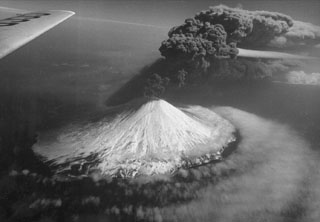Report on Alaid (Russia) — 2 January-8 January 2013
Smithsonian Institution / US Geological Survey
Weekly Volcanic Activity Report, 2 January-8 January 2013
Managing Editor: Sally Sennert.
Please cite this report as:
Global Volcanism Program, 2013. Report on Alaid (Russia) (Sennert, S, ed.). Weekly Volcanic Activity Report, 2 January-8 January 2013. Smithsonian Institution and US Geological Survey.
Alaid
Russia
50.861°N, 155.565°E; summit elev. 2285 m
All times are local (unless otherwise noted)
According to KVERT, observers on both Paramushir (SE) and Shumshu islands reported weak gas-and-steam plumes containing small amounts of ash from Alaid during 5, 11, 16-17, 23, and 27-28 October 2012. Photos taken on 27 October showed ash deposits on the cone and a small cinder cone growing in the crater. The cone was again covered by ash on 8 November. Seismicity increased on 16 November and remained elevated until 6 December, when it decreased until 10 December. Technical problems prevented seismic recordings after that. Satellite imagery showed a weak thermal anomaly on the volcano until 12 December. On 8 January 2013 the Aviation Color Code was lowered to Green.
Geological Summary. The highest and northernmost volcano of the Kuril Islands, Alaid is a symmetrical stratovolcano when viewed from the north, but has a 1.5-km-wide summit crater that is breached open to the south. This basaltic to basaltic andesite volcano is the northernmost of a chain constructed west of the main Kuril archipelago. Numerous pyroclastic cones are present the lower flanks, particularly on the NW and SE sides, including an offshore cone formed during the 1933-34 eruption. Strong explosive eruptions have occurred from the summit crater beginning in the 18th century. Reports of eruptions in 1770, 1789, 1821, 1829, 1843, 1848, and 1858 were considered incorrect by Gorshkov (1970). Explosive eruptions in 1790 and 1981 were among the largest reported in the Kuril Islands.

